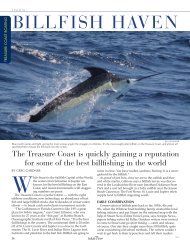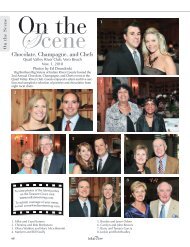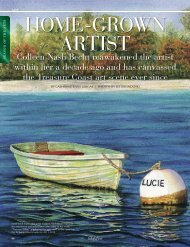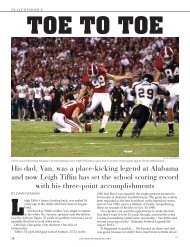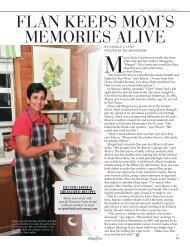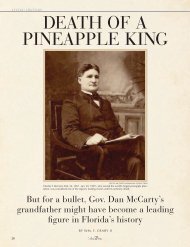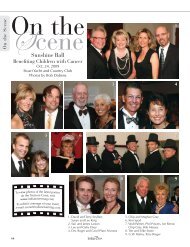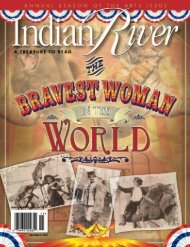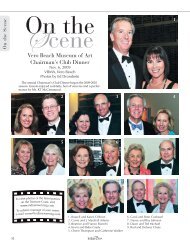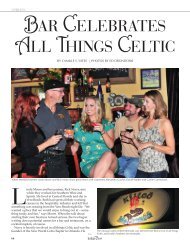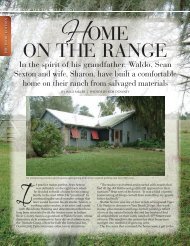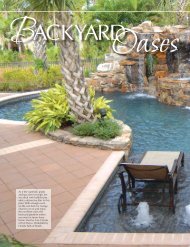SCULPTURE RESURFACES AFTER CARRIED BY TORNADO
SCULPTURE RESURFACES AFTER CARRIED BY TORNADO
SCULPTURE RESURFACES AFTER CARRIED BY TORNADO
Create successful ePaper yourself
Turn your PDF publications into a flip-book with our unique Google optimized e-Paper software.
ART<br />
<strong>SCULPTURE</strong> <strong>RESURFACES</strong><br />
<strong>AFTER</strong> <strong>CARRIED</strong> <strong>BY</strong> <strong>TORNADO</strong><br />
What is left of “Fast” sits in Craig Wedderspoon’s studio on the University of Alabama campus. Much of the sculpture was lost when it traveled over a<br />
mile away, swept up in the April 27 tornado.<br />
An aptly titled sculpture by a UA art professor<br />
is found after being blown away April 27<br />
<strong>BY</strong> MEREDITH CUMMINGS<br />
PHOTOS <strong>BY</strong> SCOTT BOWMAN<br />
When University of Alabama art professor Craig<br />
Wedderspoon named his sculpture “Fast,” he<br />
could not envision how fast it would go.<br />
When the aluminum sculpture, which weighs<br />
hundreds of pounds, was not being shown around the country,<br />
Wedderspoon kept it in Steve Miller’s pecan orchard. The<br />
work was not meant to be an outside piece — there is, after<br />
all, no way to safely bolt it down — but keeping it outside at<br />
a friend’s house seemed a safe bet.<br />
Until April 27.<br />
That’s when “Fast,” so named because of the whirlwind of<br />
vortices throughout the sculpture, went about 150 miles per<br />
hour, its welded-together aluminum squares taking flight<br />
over the city.<br />
The EF-4 tornado blew the work more than a mile away,<br />
64<br />
crimsonmagazine.net<br />
but it — most of it, anyway — came back to Wedderspoon,<br />
head of the sculpture program at the University of Alabama.<br />
Wedderspoon’s mentor, artist Lester Van Winkle, once said<br />
the piece had velocity, and mentioned that “it looked fast.”<br />
The name stuck.<br />
“There’s lots of irony to this piece,” Wedderspoon says,<br />
looking at what is left of it in his studio on campus. He has<br />
about three-quarters of the piece, which he says is basically<br />
built like a “big whiffle ball.” The rest is still missing.<br />
Just after the tornado, Wedderspoon was worried about<br />
Miller, whose home was destroyed, and went to see if he was<br />
all right. The last thing on his mind was the sculpture.<br />
“But the first thing he said to me was that my piece was<br />
gone,” Wedderspoon said. “I was just happy for him to<br />
be alive.”<br />
Wedderspoon finds it emotional to talk about events surrounding<br />
the disappearance of “Fast.” One of his sculpting<br />
students, Morgan Sigler, died in the tornado that day, and he<br />
>>
ART<br />
Wedderspoon talks about “Fast” in his studio. Jagged edges of the piece<br />
where the wind ripped it apart are visible.<br />
“Fast” is made from hundreds of<br />
welded-together aluminum squares.<br />
was en route to her funeral<br />
in Bryant, Ala., when he<br />
heard that his sculpture had<br />
been spotted on campus.<br />
Someone had dropped it<br />
off with a note saying it had<br />
been found a mile away.<br />
Professor and students<br />
are a tight-knit group.<br />
“Sculpture, by its nature,<br />
is a collaborative event,”<br />
Wedderspoon says. “A lot<br />
of people think of artists<br />
locked up in a studio sitting<br />
there doing their own thing.<br />
But at any given time you have to have people help you hold<br />
something, move something. The weight of things and the<br />
machinery involved makes sculpture a communal process.<br />
When Morgan died, it hit our kids hard.”<br />
Wedderspoon initially considered fixing “Fast” and making<br />
it an outside installation in memory of the storm victims, but<br />
he realized that it would take more than 100 hours of work to<br />
make it safe. Any outside sculpture has to be bolted down, safe<br />
for children “and drunks,” as Wedderspoon says, to play on.<br />
Wedderspoon says he is not sure what he will do with the<br />
sculpture but may use pieces for other art projects.<br />
Wedderspoon does not, however, have reservations about<br />
what he might name his next piece, for fear of its living up to<br />
its name.<br />
“I’m not superstitious,” he says, “but I was pretty happy<br />
with this piece. I consider this a critique by Mother Nature.<br />
Maybe she decided that it needed to look a little different.”<br />
crimsonmagazine.net 65



